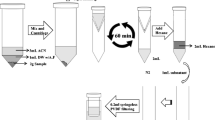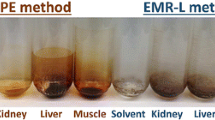Abstract
Ultrahigh-performance liquid chromatography (UHPLC) coupled with triple quadrupole tandem mass spectrometry (MS/MS) is one of the most powerful tools for the multiclass, multiresidue analysis of veterinary drugs, pesticides, mycotoxins, and other chemical contaminants in foods and other sample types. Until approximately 2010, commercial MS/MS instruments using multiple reaction monitoring (MRM) were generally limited to minimum dwell (and inter-dwell) times of 10 ms per ion transition. To achieve the needed accuracy and detection limits for hundreds of targeted analytes, older UHPLC-MS/MS methods typically acquired only two ion transitions per analyte (yielding only one ion ratio for qualitative identification purposes), which is still the norm despite technological advancements. Newer instruments permit as little as 1 ms (inter-)dwell times to afford monitoring of more MRMs/analyte with minimal sacrifices in accuracy and sensitivity. In this study, quantification and identification were assessed in the validation of 169 veterinary drugs in liquid and powdered eggs. Quantitatively, an “extract-and-inject” sample preparation method yielded acceptable 70–120% recoveries and < 25% RSD for 139–141 (82–83%) of the 169 diverse drug analytes spiked into powdered and liquid eggs, respectively, at three levels of regulatory interest. Qualitatively, rates of false positives and negatives were compared when applying three different regulatory identification criteria in which two or three MRMs/drug were used in each case. Independent of the identification criteria, rates of false positives remained <10% for 95–99% of the drugs whether 2 or 3 ions were monitored, but the percent of drugs with >10% false negatives decreased from 25–45 to 10–12% when using 2 vs. 3 MRMs/analyte, respectively. Use of a concentration threshold at 10% of the regulatory level as an identification criterion was also very useful to reduce rates of false positives independent of ion ratios. Based on these results, monitoring >2 ion transitions per analyte is advised when using MS/MS for analysis, independent of SANTE/12682/2019, FDA/USDA, or 2002/657/EC identification criteria. (Quant)identification results using all three criteria were similar, but the SANTE criteria were advantageous in their greater simplicity and practical ease of use.
Graphical abstract









Similar content being viewed by others
References
van der Gugten JG. Tandem mass spectrometry in the clinical laboratory: a tutorial overview. Clin Mass Spectrom. 2020;15:36–43.
Lopez-Ruiz R, Romero-Gonzalez R, Garrido-Frenich A. Ultrahigh-pressure liquid chromatography-mass spectrometry: an overview of the last decade. Trends Anal Chem. 2019;118:170–81.
Berendsen BJA, Meijer T, Mol HGJ, van Ginkel L, Nielen MWF. A global inter-laboratory study to assess acquisition modes for multi-compound confirmatory analysis of veterinary drugs using liquid chromatography coupled to triple quadrupole, time of flight and orbitrap mass spectrometry. Anal Chim Acta. 2017;962:60–72.
Kaufmann A, Butcher P, Maden K, Walker S, Widmer M. Reliability of veterinary drug residue confirmation: high resolution mass spectrometry versus tandem mass spectrometry. Anal Chim Acta. 2015;856:54–67.
Kaufmann A, Butcher P, Maden K, Walker S, Widmer M. Quantitative and confirmative performance of liquid chromatography coupled to high-resolution mass spectrometry compared to tandem mass spectrometry. Rapid Commun Mass Spectrom. 2011;25:979–92.
Kaufmann A, Butcher P, Maden K, Walker S, Widmer M. Comprehensive comparison of liquid chromatography selectivity as provided by two types of liquid chromatography detectors (high resolution mass spectrometry and tandem mass spectrometry): “where is the crossover point?”. Anal Chim Acta. 2010;673:60–72.
Lehotay SJ, Sapozhnikova Y, Mol HGJ. Current issues involving screening and identification of chemical contaminants in foods by mass spectrometry. Trends Anal Chem. 2015;69:62–75.
Lehotay SJ, Mastovska K, Amirav A, Fialkov AB, Alon T, Martos PA, et al. Identification and confirmation of chemical residues in food by chromatography-mass spectrometry and other techniques. Trends Anal Chem. 2008;27:1070–90.
Zomer P, Mol HGJ. Simultaneous quantitative determination, identification and qualitative screening of pesticides in fruits and vegetables using LC-Q-Orbitrap™-MS Food. Addit Contam A. 2015;32:1628–36.
Kadokami K, Ueno D. Comprehensive target analysis for 484 organic micropollutants in environmental waters by the combination of tandem solid-phase extraction and quadrupole time-of-flight mass spectrometry with sequential window acquisition of all theoretical fragment-ion spectra acquisition. Anal Chem. 2019;91:7749–55.
Lozano A, Ferrer C, Fernández-Alba AR. Selectivity enhancement using sequential mass isolation window acquisition with hybrid quadrupole time-of-flight mass spectrometry for pesticide residues. J Chromatogr A. 2019;1591:99–109.
Kaufmann A. The use of UHPLC, IMS, and HRMS in multiresidue analytical methods: a critical review. J Chromatogr B. 2020;55:e4533.
Kaufmann A. Combining UHPLC and high-resolution MS: a viable approach for the analysis of complex samples? Trends Anal Chem. 2014;63:113–28.
Kaufmann A. Analytical performance of the various acquisition modes in Orbitrap MS and MS/MS. J Mass Spectrom. 2018;53:725–38.
Bethem R, Boison J, Gale J, Heller D, Lehotay S, Loo J, et al. Establishing the fitness for purpose of mass spectrometric methods. J Am Soc Mass Spectrom. 2003;14:528–41.
US Department of Health and Human Services, Food and Drug Administration, Center for Veterinary Medicine (2003) Guidance for industry #118, Rockville, MD, USA.
Commission Decision 2002/657/EC. Off Eur Commun 2002; L221:8–36.
SANTE/12682/2019. Method validation & quality control procedures for pesticide residues in food & feed. (https://ec.europa.eu/food/sites/food/files/plant/docs/pesticides_mrl_guidelines_wrkdoc_2019-12682.pdf).
Mol HGJ, Zomer P, García-López M, Fussell RJ, Scholten J, de Kok A, et al. Identification in residue analysis based on liquid chromatography with tandem mass spectrometry: experimental evidence to update performance criteria. Anal Chim Acta. 2015;873:1–13.
Heideloff C, McShane AJ, Bunch DR, Lembright K, Lawson S, Wang S. Monitoring two transitions by LC–MS/MS may not be sufficient to positively identify benzoylecgonine in patient urine samples. Clin Chim Acta. 2016;456:67–8.
Bunch DR, McShane AJ, Wang S. Investigation of transition ion ratio variation for liquid chromatography tandem mass spectrometry: a case study approach. Clin Chim Acta. 2018;486:205–8.
Lehotay SJ, Mastovska K, Lightfield AR, Dutko T, Ng C, Bluhm L. Rapid analysis of aminoglycoside antibiotics in bovine tissues using disposable pipette extraction and ultrahigh performance liquid chromatography-tandem mass spectrometry. J Chromatogr A. 2013;1313:103–12.
Schürmann A, Dvorac V, Crüzer C, Butcher P, Kaufmann A. False-positive liquid chromatography/tandem mass spectrometric confirmation of sebuthylazine residues using the identification points system according to EU directive 2002/657/EC due to a biogenic insecticide in tarragon. Rapid Commun Mass Spectrom. 2009;23:1196–200.
Lehotay SJ. Possibilities and limitations of isocratic fast liquid chromatography - tandem mass spectrometry analysis of pesticide residues in fruits and vegetables. Chromatographia. 2019;82:235–50.
Lehotay SJ, Lightfield AR. Extract-and-inject analysis of veterinary drug residues in catfish and ready-to-eat meats by ultrahigh-performance liquid chromatography – tandem mass spectrometry. J AOAC Int. 2020;103:584–606.
USDA Food Safety and Inspection Service. Screening and Confirmation of Animal Drug Residues by UHPLC-MS-MS. CLG-MRM3 (www.fsis.usda.gov/wps/wcm/connect/8e9f2715-058c-4977-aa6c-fba9b8bb2ad4/CLG-MRM3.02.pdf?MOD=AJPERES accessed Feb 2021).
Anumol T, Lehotay SJ, Stevens J, Zweigenbaum J. Comparison of veterinary drug residue results in animal tissues by ultrahigh-performance liquid chromatography coupled to triple quadrupole or quadrupole-time-of-flight tandem mass spectrometry after different sample preparation methods, including use of a commercial lipid removal product. Anal Bioanal Chem. 2017;409:2639–53.
Monteiro SH, Lehotay SJ, Sapozhnikova Y, Ninga E, Lightfield AR. High-throughput mega-method for the analysis of pesticides, veterinary drugs, and environmental contaminants by ultra-high-performance liquid chromatography−tandem mass spectrometry and robotic mini-solid-phase extraction cleanup + low-pressure gas chromatography−tandem mass spectrometry, part 1: beef. J Agric Food Chem. 2021;69:1159–68.
Ninga E, Sapozhnikova Y, Lehotay SJ, Lightfield AR, Monteiro SH. High-throughput mega-method for the analysis of pesticides, veterinary drugs, and environmental contaminants by ultra-high-performance liquid chromatography−tandem mass spectrometry and robotic mini-solid-phase extraction cleanup + low-pressure gas chromatography−tandem mass spectrometry, part 2: catfish. J Agric Food Chem. 2021;69:1169–74.
Lehotay SJ, Lightfield AR. Simultaneous analysis of aminoglycosides with many other classes of drug residues in bovine tissues by ultrahigh-performance liquid chromatography-tandem mass spectrometry using an ion-pairing reagent added to final extracts. Anal Bioanal Chem. 2018;410:1095–109.
Lehotay SJ, Lightfield AR. Comparison of four different multiclass, multiresidue sample preparation methods in the analysis of veterinary drugs in fish and other food matrices. Anal Bioanal Chem. (in press).
Dubois M, Fluchard D, Sior E, Delahaut P. Identification and quantification of five macrolide antibiotics in several tissues, eggs and milk by liquid chromatography–electrospray tandem mass spectrometry. J Chromatogr A. 2001;753:189–202.
Wang C, Li X, Yu F, Wang Y, Ye D, Hu X, et al. Multi-class analysis of veterinary drugs in eggs using dispersive-solid phase extraction and ultra-high performance liquid chromatography-tandem mass spectrometry. Food Chem. 2021;334:127598.
Jimenez V, Rubies A, Centrich F, Companyo R, Guiteras J. Development and validation of a multiclass method for the analysis of antibiotic residues in eggs by liquid chromatography – tandem mass spectrometry. J Chromatogr A. 2011;1218:1443–51.
Kang JW, Park SJ, Park HC, Hossain MA, Kim MA, Son SW, et al. Multiresidue screening of veterinary drugs in meat, milk, egg, and fish using liquid chromatography coupled with ion trap time-of-flight mass spectrometry. Appl Biochem Biotechnol. 2017;182:635–52.
Platkowska M, Gbylik-Silorska M, Gajda A, Jedziniak P, Bladek T, Zmudzki J, et al. Multiresidue determination of veterinary medicines in lyophilized egg albumen with subsequent consumer exposure evaluation. Food Chem. 2017;229:646–52.
Varenina I, Bilandzic N, Kolanovic BS, Bozic D, Sedak M, Dokic M, et al. Validation of a liquid chromatography – tandem mass spectrometry method for the simultaneous determination of sulfonamides, trimethoprim and dapsone in muscle, egg, milk and honey. Food Addit Contam A. 2016;33:656–67.
Hou X, Xu X, Xu X, Han M, Qiu S. Application of a multiclass screening method for veterinary drug and pesticides using HPLC-QTOF-MS in egg samples. Food Chem. 2020;309:125746.
Luo P, Liu X, Kong F, Chen L, Wang Q, Li W, et al. Simultaneous determination of 169 veterinary drugs in chicken eggs with EMR-Lipid cleanup using ultra-high performance liquid chromatography tandem mass spectrometry. Anal Methods. 2019;11:1657–62.
Pontes FLD, Gasparetto JC, de Francisco TMG, Goetzke HC, Leonart LP, de Jesus DA, et al. Development and validation of a multiclass method for the analysis of veterinary drug residues in eggs using liquid chromatography - tandem mass spectrometry. Food Anal Methods. 2017;10:1063–77.
Dasenaki ME, Thomaidis NS. Multi-residue determination of 115 veterinary drugs and pharmaceutical residues in milk powder butter, fish tissue and eggs using liquid chromatography – tandem mass spectrometry. Anal Chim Acta. 2015;880:103–21.
Lehotay SJ. Utility of the summation chromatographic peak integration function to avoid manual reintegrations in the analysis of targeted analytes. LCGC N Am. 2017;25:391–402.
Acknowledgements
The author thanks Alan Lightfield for his laboratory assistance, and John Johnston, Louis Bluhm, Terry Dutko, Eric Flynn, John Jarosh, and others in the FSIS Eastern, Midwest, and Western Laboratories who provided the liquid and powdered eggs in the study.
Author information
Authors and Affiliations
Corresponding author
Ethics declarations
Conflict of interest
The author declares no competing interests.
Additional information
Publisher’s note
Springer Nature remains neutral with regard to jurisdictional claims in published maps and institutional affiliations.
Disclaimer: Mention of brand or firm name does not constitute an endorsement by the U.S. Department of Agriculture or the U.S. Food and Drug Administration above others of a similar nature not mentioned. USDA is an equal opportunity provider and employer.
Published in the topical collection celebrating ABCs 20th Anniversary.
Supplementary information
ESM 1
(PDF 777 kb)
Rights and permissions
About this article
Cite this article
Lehotay, S.J. Comparison of analyte identification criteria and other aspects in triple quadrupole tandem mass spectrometry: Case study using UHPLC-MS/MS for regulatory analysis of veterinary drug residues in liquid and powdered eggs. Anal Bioanal Chem 414, 287–302 (2022). https://doi.org/10.1007/s00216-021-03380-x
Received:
Revised:
Accepted:
Published:
Issue Date:
DOI: https://doi.org/10.1007/s00216-021-03380-x




